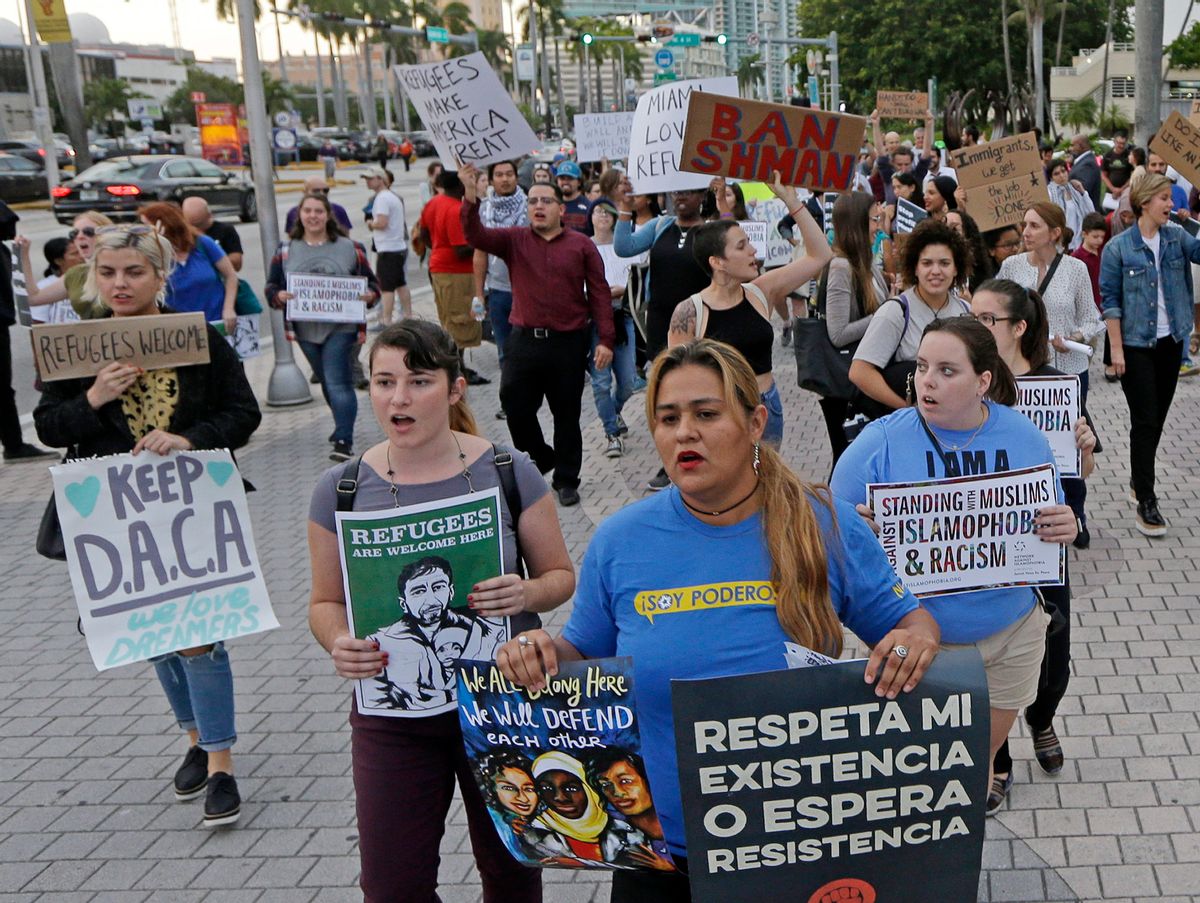Editor’s note: The following is a roundup of archival stories related to Iraq, Iran, Syria, Yemen, Sudan, Libya and Somalia.
Last week, President Trump signed an executive order temporarily banning citizens from seven countries from entering the U.S. and indefinitely banning Syrian refugees.
The stated aim of the order is to ensure the U.S. doesn’t allow terrorists into the country.
Why did the Trump administration single out these seven countries? As many commentators have pointed out, they are all majority Muslim. Another commonality is war.
Iraq and Syria
The destabilizing force of the militant organization Islamic State (IS or ISIS) has been especially strong in Iraq and Syria. In June 2014, IS shook the world by overrunning the Iraqi city of Mosul. Taking advantage of political weaknesses and ethic division in Iraq and neighboring Syria, IS grew rapidly to the point where 10 million people lived under its power, according to the BBC.
The Syrian government and Russia and – acting separately – a U.S.-led coalition pushed back against IS. They dropped tens of thousands of airstrikes that weakened IS and leveled Syrian cities. By late October 2016, IS had been diminished to the point that University of California professor James L. Gelvin considered five possible scenerios for its demise.
But the violence displaced more than three million Iraqis in the span of 18 months prior to the U.S. presidential election. This left humanitarian aid agencies struggling to meet the demand for assistance, wrote Thomas Acaro of Elon University in November. His survey of international aid workers revealed stress in the system:
“A lack of safety is an increasingly palpable fact of life. They report seeing friends and colleagues get raped, kidnapped and, yes, even beheaded.
Airstrikes in November 2016 also destroyed the two largest hospitals in the Syrian city of Aleppo. M. Zaher Sahloul, a physician and professor at the University of Illinois at Chicago, traveled there as a volunteer and wrote about the medical nightmare affecting thousands of civilians:
"Physicians for Human Rights has recorded 382 attacks on medical facilities, of which 344 were carried out by the regime and Russia; they were also responsible for the deaths of 703 of the 757 medical personnel killed in the war so far. Most of Aleppo’s doctors have left.”
Libya
After Libyan dictator Moammar Gadhafi was overthrown by a militia-led uprising in 2011, the U.S. and other Western countries supported efforts to elect a new, democratic government. By February of 2015, the U.S. was bombing parts of Libya in an effort to extinguish IS strongholds in the North African country. What went wrong? Mieczyslaw Boduszynski,
a former U.S. diplomat who worked in Libya during the post-Gadhafi transition, explained:
“Over time, the vast unguarded borders and lawlessness of post-Gadhafi Libya provided the ideal environment for jihadists of various stripes to set up bases. For IS, Libya provide[d] an opportunity not only to extend the caliphate, but to do so far away from coalition airstrikes in Syria and Iraq.”
Iran
While threatened by the spread of IS in neighboring Iraq, Iran’s government celebrated a victory in 2015 when the the Obama administration and five other countries agreed to lift sanctions against Iran in return for the country’s voluntary curbing of its nuclear ability.
Scholars at Indiana University, Bloomington wrote: “As sanctions fall away, Iran should rise swiftly back into the major leagues, propelled by larger energy exports that could top $100 billion a year, the release of hitherto frozen funds and a highly educated and motivated workforce.”
But the deal may have been short-lived. As David Mednicoff of University of Massachusetts Amherst observed, “Trump has … promised to renegotiate the multilateral treaty that stopped Iran’s move toward nuclear weapons.”
Mednicoff also noted another potential source of instability: Iran’s relationships in the region.
“Arab Gulf states frequently express anxiety around Iran’s power. They see Iran as a threat to their countries’ autonomy and to the majority Sunni Islam that differs from the assertive minority Shi’ism central to Iran’s political ideology.”
Yemen
Civil war has been raging for nearly two years in Yemen. The U.N. has called the conflict a “major calamity.”
Vincent Durac of the University College Dublin traces the origins of the war to 2011 when a rebellion unseated the country’s president, Ali Abdullah Saleh, whose party had dominated the country’s political life since Yemeni unification in 1990. But what really triggered the conflict was the years of failed transitional negotiations that followed Saleh’s ousting.
“More than 10,000 people have lost their lives, while more than 20 million (of a total population of some 27 million) are in need of humanitarian assistance. More than 3 million people are internally displaced, while hundreds of thousands have fled the country altogether. There are reports of looming famine as the conflict destroys food production in the country.”
Somalia and Sudan
Robert Rotberg of Harvard’s Kennedy School suggested another reason why IS may have asserted control in northern African countries. “Terrorists are in it as much for the loot as for the ideology,” he wrote.
“ISIS- and al-Qaida-linked groups in Africa prosper by trafficking drugs across the Sahara and by offering "protection” to smugglers who have long been trading illicit goods throughout the continent. Although Westerners tend to think of these groups as driven by ideology, new recruits may be more attracted by opportunities to make money.
Simon Reich of Rutgers, Newark cautions that:
“we may have been entering a new form of global war for the last three decades – in slow motion. This war is similar in some respects to prior incarnations, and significantly different in others. First, all wars have a geographic fulcrum. This one is in the Middle East and North Africa. Its epicenter spreads from Libya and Egypt to the Persian Gulf and Turkey.”
![]()
Danielle Douez, Associate Editor, Politics + Society, The Conversation and Emily Costello, Senior Editor, Politics + Society, The Conversation



Shares